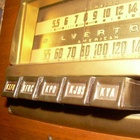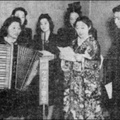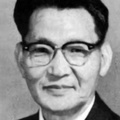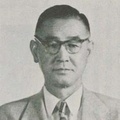In July 1932, Los Angeles was buzzing with the local Olympics. However, no agreement could be reached on broadcasting rights in the United States, and the games were not broadcast on the radio domestically. In order to deliver the latest news, the California Mainichi newspaper (Kamae) decided to call the Mitsuba Trading Company in San Pedro, Little Tokyo, from the stadium where the games were being held, and broadcast the audio in their store every day from 2:00 p.m. This was Kamae's attempt at cable broadcasting.
The scene was described as "a crowd of about 700 people gathered in front of the store, yelling and cheering into the loudspeakers as the news came in." (California Mainichi, August 1, 1932)
About four years later, on February 6, 1936, California Mainichi Broadcasting System launched as KGER. The station was based in Long Beach, but had its studio in a building near Little Tokyo. Ozamoto was selected as the announcer. After studying at Waseda University, Ozamoto worked as a Japanese language teacher and an executive of the Buddhist Youth Association, and was a well-known face in the Japanese community. At first, newspaper employees were scheduled to take turns as announcers, but Ozamoto's reputation was unexpectedly high, and he was made the exclusive announcer.
The contents of the broadcast consisted of entertainment and a speech by President Fujii. Although it was sponsored by the newspaper, it seems that no news was broadcast. As for entertainment, each episode featured one district, such as Hollywood, Keystone, San Fernando, or Hawthorne, and talented performers belonging to the local support groups and chapters were invited to appear on the program. The results of daily practice, such as reciting poetry, folk songs, and dodoitsu, were presented. November 19, 1961, was a kind of in-house talent show, and the performances, which were received with great acclaim, included dodoitsu by Tokyo branch president Komatsu Yoshimoto, biwa "Taiwan Entry" by Hata Kinsei, who had only just joined the sales department in September of the same year, ondo by factory manager Terada Kazuo, and "Sado Okesa" by editor-in-chief Matsui Toyozo.

In addition to entertainment, the lecture by President Sei Fujii was an essential part of every event. "I have a habit of using my hands and feet more than my mouth," he said in his own words (California Mainichi, February 5, 1936). However, compared to a normal lecture, the lecture was extremely short, less than 10 minutes, and he had a hard time conveying his facial expressions and attitude.
On March 12, 1963, an announcement was published in the paper stating, "We have decided to discontinue the Akakamei Broadcasting Program, which has been a nuisance for a long time, as of the 16th of this month." The explanation given was that the monthly expenses of $200 had become too much of a burden.
However, even after the cancellation on March 23, the program guide was published as if nothing had happened. When I looked into it again, I found an article by a local correspondent announcing that the program would continue, in a small enough detail that you would not notice it unless you looked carefully, and this convinced me.
Being a tight-knitted group, the Kagawa Supporters Association is likely to have raised the voice that if the reason for the cancellation was simply financial, then the show should continue, with everyone covering the shortfall. In fact, the number of advertisements increased dramatically after the cancellation announcement, from an average of nine companies to 20 companies, and a shocking maximum of 30 companies were advertising on each show. In a sense, the shock therapy worked.
As a project unique to the California Mainichi Shimbun, which took a stance in support of Japan and approval of the actions of the Japanese military, the newspaper aired special programs such as the "Victory Gratitude Broadcast" to commemorate the fall of Guangzhou and Hankou during the Sino-Japanese War, and the "Second Anniversary Broadcast of the Sino-Japanese Incident," which were highly praised by core listeners.
On February 8, 1940, Ozamoto retired from his job as an announcer and became the secretary of the Gardena Plains Japanese Association. He was succeeded by Junko Maruya from the sales department. Maruya would later become the general manager of the California Mainichi Newspaper, which was relaunched after the war. California Mainichi Broadcasting continued its programming until the outbreak of war between Japan and the United States.
Continued >>
*This article is an excerpt from Japan Hour (2020) and reprinted from The Rafu Shimpo (May 8, 2021).
© 2022 Tetuya Hirahara








